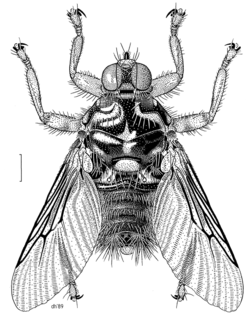
Endopterygota, also known as Holometabola, is a superorder of insects within the infraclass Neoptera that go through distinctive larval, pupal, and adult stages. They undergo a radical metamorphosis, with the larval and adult stages differing considerably in their structure and behaviour. This is called holometabolism, or complete metamorphism.

The Phoridae are a family of small, hump-backed flies resembling fruit flies. Phorid flies can often be identified by their escape habit of running rapidly across a surface rather than taking to the wing. This behaviour is a source of one of their alternate names, scuttle fly. Another vernacular name, coffin fly, refers to Conicera tibialis. About 4,000 species are known in 230 genera. The most well-known species is cosmopolitan Megaselia scalaris. At 0.4 mm in length, the world's smallest fly is the phorid Euryplatea nanaknihali.

The Lonchopteridae are a family of small (2–5 mm), slender, yellow to brownish-black Diptera, occurring all over the world. Their common name refers to their pointed wings, which have a distinct venation. Many are parthenogenic; males are very rare, however, at least in North American species, and have a somewhat different venation than do the females.

The Brachyceran infraorder Muscomorpha is a large and diverse group of flies, containing the bulk of the Brachycera, and, most of the known flies. It includes a number of the most familiar flies, such as the housefly, the fruit fly, and the blow fly. The antennae are short, usually three-segmented, with a dorsal arista. Their bodies are often highly setose, and the pattern of setae is often taxonomically important.

Platypezidae is a family of true flies of the superfamily Platypezoidea. The more than 250 species are found worldwide primarily in woodland habitats. A common name is flat-footed flies, but this is also used for the closely related Opetiidae which were included in the Platypezidae in former times.

The fly Megaselia scalaris is a member of the order Diptera and the family Phoridae, and it is widely distributed in warm regions of the world. The family members are commonly known as the "humpbacked fly", the "coffin fly", and the "scuttle fly". The name "scuttle fly" derives from the jerky, short bursts of running, characteristic to the adult fly. The name "coffin fly" is due to their being found in coffins, digging six feet deep in order to reach buried corpses. It is one of the more common species found within the family Phoridae; more than 370 species have been identified within North America.
In forensic entomology, entomotoxicology is the analysis of toxins in arthropods that feed on carrion. Using arthropods in a corpse or at a crime scene, investigators can determine whether toxins were present in a body at the time of death. This technique is a major advance in forensics; previously, such determinations were impossible in the case of severely decomposed bodies devoid of intoxicated tissue and bodily fluids. Ongoing research into the effects of toxins on arthropod development has also allowed better estimations of postmortem intervals.

The Pyrgotidae are an unusual family of flies (Diptera), one of only two families of Cyclorrhapha that lack ocelli. Most species are "picture-winged", as is typical among the Tephritoidea, but unlike other tephritoids, they are endoparasitoids; the females pursue scarab beetles in flight, laying an egg on the beetle's back under the elytra where the beetle cannot reach it. The egg hatches and the fly larva enters the body cavity of the beetle, feeding and eventually killing the host before pupating. In the United States, some species of Pyrgota and Sphecomyiella can be quite common in areas where their host beetles are abundant. Like their host beetles, these flies are primarily nocturnal, and are often attracted to artificial lights.

Lonchoptera is a genus of spear-winged flies (Lonchopteridae). Their common name refers to their subacute (pointed) wings, which have a distinct and sexually dimorphic venation.

Hippobosca equina, also known as the forest fly or New Forest fly, is a biting fly from the family Hippoboscidae. They are blood-feeding ectoparasites of primarily horses and other large mammals including cattle. It is a permanently fully winged fly, not shedding its wings on finding its host, as in some other Hippoboscidae. With its wings retained, it may thus fly away from its host to deposit its larvae. They are good fliers.

Arachnomyia is a genus of flies in the family Dolichopodidae. It is known from Australia.
Ironomyiidae is a small family of flies in the order Diptera. Historically, they had been included in the family Platypezidae, and includes three extant species and a number of extinct fossil species.

Melaloncha is a genus of phorid flies commonly referred to as "bee-killing flies". They are found almost exclusively in the Neotropical region, although there is one record from extreme southern Texas, United States. They are small flies, usually about 2–3 millimetres (0.08–0.12 in) in length. No true fossils are known, although there are some specimens in Colombian copal, of unknown age.

The Metopininae are a subfamily of flies in the family Phoridae.

Lonchoptera bifurcata is a species of spear-winged or pointed-winged flies in the family Lonchopteridae. It has a Holarctic distribution and is present in Europe, Asia and North America.

The tiger bee fly, Xenox tigrinus, is an insect of the family Bombyliidae found in the eastern United States and southern Ontario. It formerly went by the name Anthrax tigrinus. The distinctive wing pattern may resemble tiger stripes, giving the tiger bee fly its name. Like other members of the bee fly family, the tiger bee fly parasitizes the larvae of other insects.

The Metopininae is a tribe of flies in the family Phoridae.
Syneura is a genus of flies in the family Phoridae.
Metopina is a genus of flies in the family Phoridae.
Myriophora is a genus of flies in the family Phoridae.













